The Long Drag
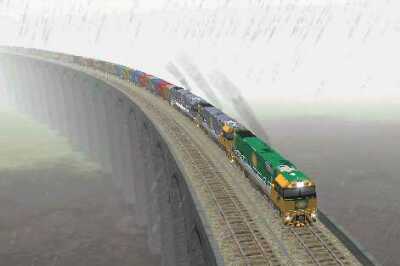
|
| Ribblehead Viaduct in weather so typical of the region. The locos aren't typical of this region, however! |
This article by Jeremy North originally appeared in the June 1963 edition of the English Meccano Magazine, Vol XLVIII No. 96 (priced at 1/6).
Whenever I think of the Settle-Carlisle railway line, which crosses the mighty Pennines to link Ribblesdale with the Eden Valley, and England with Scotland, my thoughts dwell mainly on the first twenty miles. They are known to railwaymen - and particularly to the hard-working firemen of the steam locomotives - as the Long Drag. Here, the track climbs for more than 700 feet, with a ruling gradient of 1 in 100, to a height of 1,190 feet above sea level. It passes through some of the bleakest country in England, and includes water-troughs that are the highest in the world.
About 70 inches of rain a year descend on the permanent way and on the lanky viaducts. A local farmer was not far out when he told the engineers of the 1870's that they would have to build the railway on stilts!
Ribblehead
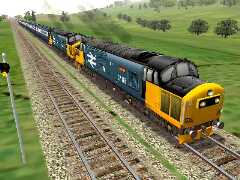
|
| A pair of BR Class 37s working hard up the grade at Horton. |
At Ribblehead, where a viaduct 1,320 feet long was thrown across the valley, the westerly gales are sometimes so strong that they stop trains as they leave the little station which, by the way, is a valuable weather-recording point for the Air Ministry.
Building the Long Drag called for some massive engineering works. It is very difficult to maintain in such wild country. Yet, every 24 hours, there are 100 trains on the line, including crack expresses like the "Waverley" and the "Thames-Clyde", which descend the incline at speeds around 80 miles per hour. Of course, nothing approaching this speed is reached on the way up, and mercifully there are some diesel locomotives today which do away with the job of coal-shovelling.
One of the fastest down-trips was undertaken during the last war when some ammunition wagons broke loose near Ribblehead. They stayed on the line throughout their runaway trip - but did not stop until they were between Settle and Long Preston.
The railway - and the Long Drag - begins between these two places with an impressive embankment which lifts the tracks steeply from river level. From the windows of a Carlisle-bound express you look out on banks of naked rock, the result of extensive blasting, during the first few miles. Most of the Drag was constructed by the Midland Railway who tackled the job between Settle Junction and Dent Head viaduct. William H. Ashwell was the contractor's agent. The first sod of the whole 72-mile system was cut at Anley House, below Settle, in November, 1869.
The viaduct
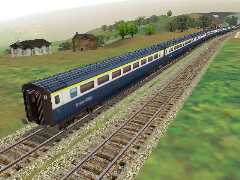
|
| A passenger train stands at Dent station on a bleak, rainy day. |
A major headache for the builders of the railway was Sheriff Brow, and the viaduct made to take the tracks across the turbulent River Ribble is on the skew. So is the next viaduct, near Holwith Bridge, where the railway actually runs on the site of the old river bed. The Ribble, at that point, was directed into a new course. The wildest country is reached between Horton-in-Ribblesdale, from which there is a splendid view of the lion-like Penyghent, 2,273 feet high.
So, to Ribblehead, where the station stands at a height of 1,000 feet above seal level and at a point where two valleys meet - those of the Ribble and westwards-facing Chapel-le-Dale, up which roar winds with speeds up to 80 miles an hour.
Trains leaving the station for the crossing of the 1,320-foot long Ribblehead Viaduct are sometimes battered to a standstill by the gales, and wait helplessly for another train to push them across. This is one case where the old railway rule of "one train, one section" is cautiously waived.
Wagon sheets are plucked from their place and blown across the country like leaves. Heavily-laden goods trains are sometimes so short of steam through tackling the Long Drag itself that they rest awhile at Ribblehead to recover before taking on the 1 in 82 gradient to Blea Moor.
The viaduct has 24 spans, and its legs were sunk 25 feet below the level of the surrounding moor to rest on solid rock. About 1,500,000 bricks were used for the arches. Into the structure went local limestone, including pieces weighout eight tons each!
Blea Moor tunnel
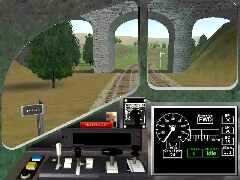
|
| From a BR Class 37 cab at Dent station, we see one of the many road viaducts crossing the Long Drag. |
Beyond, cutting through the high and lonely hills, where the sheep graze, is mighty Blea Moor Tunnel, 2,629 yards long, and at one point, about 500 feet below ground level. The tunnel was made between 1870 and 1875 and it cost 45 pounds a yard. Hundreds of navvies worked by the light of candles, and this item alone cost the Midland Railways 50 pounds a month. The builders used dynamite, then a new type of explosive, at a cost of 200 pounds a ton.
A track leads over Blea Moor, above the tunnel, and you come across the tunnel's three ventilation shafts, one of them 390 feet deep. When a train has passed through the tunnel the smoking shafts give the appearance of a volcano. In the tunnel itself, moisture and sulphur play such havoc with the track that it is replaced every four five years.
The 200-yards long Dent Head Viaduct has ten arches, the highest of them lifting the tracks 100 feet above the ground. The work on it was temporarily hold up by a waterspout in July, 1870. It burst on Blea Moor; a trickling stream became a torrent and the swollen waters carried railway material down the valley, some of it for five miles. Not far away, although it is rarely seen by casual visitors to the district, is Arten Gill, which is 220 yards long, with a maximum height of 117 feet.
Dent and Garsdale
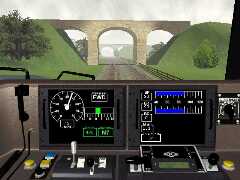
|
| Another of the many road viaducts on the Long Drag, this time from the cab of a modern diesel-electric loco. |
Now the railway is on a ledge cut from the flanks of Widdale Fell, and some 300 feet above the level of the river in Dent-dale. The station at Dent, approached from the valley by a steep macadam road, has three lines of railway sleepers as a barrier against drifting snow, and the platforms are 1,150 feet above sea level. Early this year (i.e., 1963) they vanished from sight under huge drifts. The tall, detached building in which the stationmaster lives has double-paned windows to keep out the worst of the weather.
Garsdale Head, the next station, has a turntable which is almost surrounded by up-ended sleepers. They were put in place not long after some men had an engine on the turntable and it was caught by the wind, being whirled round and round. It was stopped only after sand and grit had been poured into the centre well!
Near Garsdale, the steam locomotives pick up water from the highest troughs in the world. Keeping them clear of ice in winter is an important undertaking.
The highest building - and the summit of the Long Drag - is the signal box at Aisgill, within a few yards of the spot where Yorkshire gives way to Westmoreland in the shadow of Wild Boar Fell. In this district there is the violent Helm Wind caused when cold air rising up the east side of the Pennines meets the warmer air of the Eden Valley. It plucks the water-proof sheets from the goods wagons, and sometimes even forces trains to a standstill. No trains passed the box for two months during the horror 1947 snowfall, and the box itself almost disappeared under snow.
And there you have the story of the Long Drag - one of the toughest stretches of railway line in England.
|

